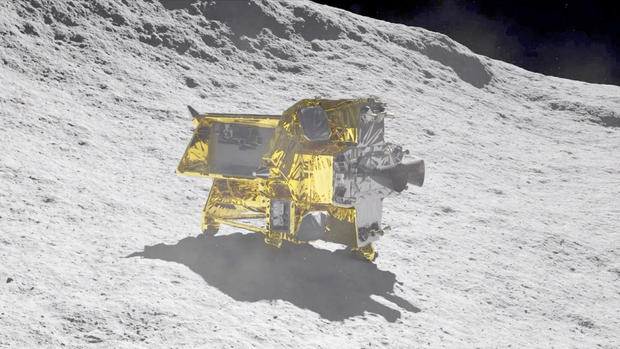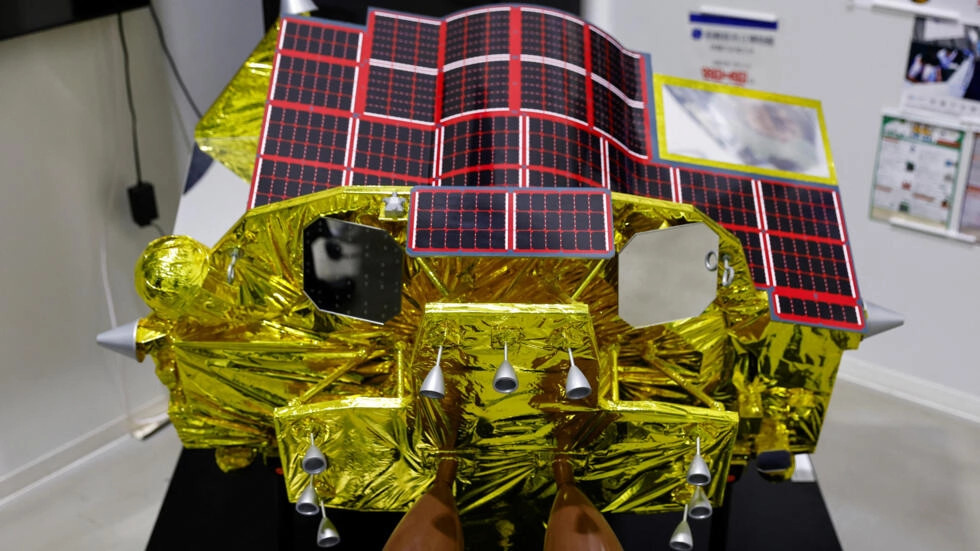Japan's previous two attempts at lunar landing has failed. In 2022 a Jaxa semi-hard lander of 14 kg cubesat lost communication before the landing. Another attempt by a private venture hard landed. This time Jaxa claimed successful soft landing.
Buuut there a glitch, the solar panel isn't generating power. The battery was at 12%, so they hastily download the data and shutdown the probe three hours after touch down.
First you've to understand the unique way SLIM is designed to land. Its nozzle is at its "side", so it land on its side.

Then it "lie" down to touch down. You can see the solar panel is at its "top", the nozzle at its "side".

This graphics dipicted how it's suppose to work.

If landing goes as planned, its solar panel would be facing upward, there's no need for unfolding. But it's not generating power, or not receiving sunlight. Data analysis show the solar panel is facing westward instead. Does this means the probe has toppled to its side while it "lie" down? So now Jaxa official hope that when the sun shone from the west, the probe will be reactivated. This may require it to survive the lunar night first.
Then it's revealed that SLIM's original purpose ... is not to overcome the night. So like Chandrayaan-3, it may not survive the night at all.
Even if it manage to wake up from westward sun light, its will not function fully as designed from reduced awake time and incorrect orientation.
Japan shuts down its SLIM moon lander in hopes it will restart someday
January 22, 202412:11 PM ET
By Bill ChappellWill Japan's moon lander get a charge from the sun — or will its mission be cut short when its battery dies?
Japan's space agency is facing that question now, even as it basks in the glow of becoming just the fifth country to achieve a soft landing on the moon. When it celebrated that feat on Friday (ET), the agency also announced that its spacecraft named SLIM, for Smart Lander for Investigating Moon, seemed unable to get electricity from its solar cell.
The Japan Aerospace Exploration Agency, or JAXA, said its engineers would study the problem, even as it raced to download data and images from the lunar mission. Three days later, it has now shut down the lander.
"At a battery level of 12%, the battery was disconnected (as planned)," JAXA said on Monday morning, adding that the lander was powered down to leave enough juice for a potential restart. The agency sounded a note of optimism that the lander might return to operation.
"According to the telemetry data, SLIM's solar cells are facing west," JAXA said. "So if sunlight begins to shine on the lunar surface from the west, there is a possibility of generating power, and we are preparing for recovery."
JAXA also confirmed that the SLIM mission, which succeeded in its precision targeting of a lunar landing site, sent a trove of information and images back to Earth before its battery ran low.
"We're currently conducting a detailed analysis, and are relieved to see that we obtained a lot of data," the agency said.
The lander will have to survive the moon's intense cold
JAXA did not specify a timeframe for when the sun might be in a favorable position that could let it supply power to the energy-starved lander. But a recent comment from Hitoshi Kuninaka, director general of Japan's Institute of Space and Astronautical Science, or ISAS, provided some clues.
The spacecraft is built to go into a type of "sleep mode" if power is lost, Kuninaka said on Friday, citing the moon's long days and nights. One lunar day lasts around 29.5 Earth days, with about two weeks each of hot sunlight and frigid darkness — although as NASA notes, definitions of a "day" vary widely.
"So if the spacecraft survives the minus-200 degree night, then in two weeks' time, it could revive again," Kuninaka said. While SLIM was built to allow for that possibility, he added, it wasn't a key factor in its design.
"SLIM's original purpose ... is not to overcome the night," Kuninaka said. "So we just have this wishful thinking that SLIM will be able to survive the night."
"If the light is on the solar cell, then the reception equipment will start working once again automatically, and then we can send a command from Earth to reawake the system."
An update is expected later this week
JAXA plans to hold a news conference later this week to share data about the moon mission. The update will likely include a more detailed prognosis on SLIM's solar cell and its less-than-ideal attitude — in this case, meaning the way the craft is oriented on the moon's surface.
"Although the attitude after landing did not go as planned, we are glad we [achieved] so much and are happy to have landed successfully," JAXA said on Monday.
Crowds of people watched the landing, which took place in the early hours of Saturday morning in Japan. A livestream from JAXA showed the lander carefully maneuvering toward the moon's surface, as SLIM's altitude ticked down to zero. It then stayed in contact, communicating from the moon.
As they announced the breakthrough, Japan's leading space officials seemed to be a bit muted, with the lander's power capabilities looming over the mission. A reporter even asked why they seemed so glum, rather than smiling.
"That would be difficult under the present circumstances," said Masaki Fujimoto, the deputy head of ISAS, according to The Asahi Shimbun. "If things had gone according to plan, I would be smiling now, but I need to know the condition [of the lander] as soon as possible."
